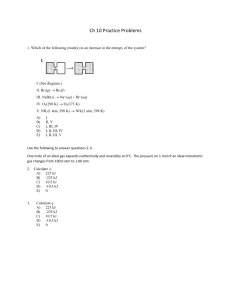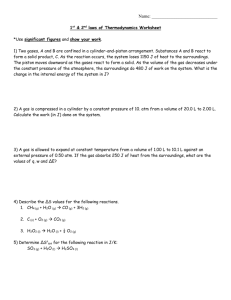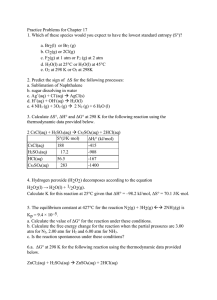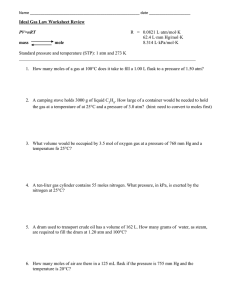Ch 10 Practice Problems
advertisement
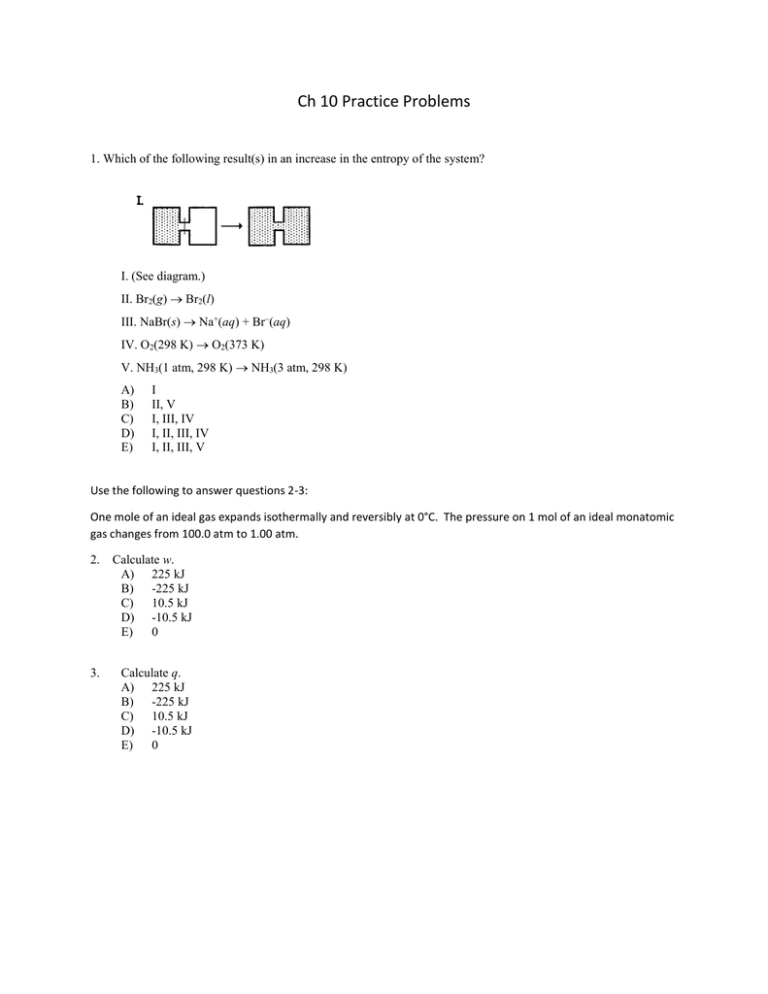
Ch 10 Practice Problems 1. Which of the following result(s) in an increase in the entropy of the system? I. (See diagram.) II. Br2(g) Br2(l) III. NaBr(s) Na+(aq) + Br–(aq) IV. O2(298 K) O2(373 K) V. NH3(1 atm, 298 K) NH3(3 atm, 298 K) A) B) C) D) E) I II, V I, III, IV I, II, III, IV I, II, III, V Use the following to answer questions 2-3: One mole of an ideal gas expands isothermally and reversibly at 0°C. The pressure on 1 mol of an ideal monatomic gas changes from 100.0 atm to 1.00 atm. 2. Calculate w. A) 225 kJ B) -225 kJ C) 10.5 kJ D) -10.5 kJ E) 0 3. Calculate q. A) 225 kJ B) -225 kJ C) 10.5 kJ D) -10.5 kJ E) 0 Use the following to answer questions 4-7: One mole of an ideal gas is compressed isothermally and reversibly at 607.4 K from 8.90 L to 5.60 L. 4. A) B) C) D) E) Calculate q. 298 kJ -2.34 kJ 2.34 kJ -298 kJ none of these 5. Calculate w. A) 298 kJ B) -2.34 kJ C) 2.34 kJ D) -298 kJ E) none of these 6. Calculate H. A) 0 kJ B) -2.34 kJ C) 2.34 kJ D) 3.85 kJ E) none of these 7. Calculate S. A) 2.34 J/K B) -2.34 J/K C) -3.85 J/K D) 3.85 J/K E) 0 8. Calculate the entropy change when 5.00 mol of a monatomic ideal gas is cooled from 135°C to 85°C at 1 atm. A) -250.0 J/K B) -9.62 J/K C) -48.9 J/K D) -13.6 J/K E) -2.74 J/K 9. Which of the following is true? A) As long as the disorder of the surroundings is increasing, a process will be spontaneous. B) For any process, Ssurr and Ssys have opposite signs. C) If Ssurr = -Ssys , the process is at equilibrium. D) H° is zero for a chemical reaction at constant temperature. E) none of these 10. Choose the correct statement. A) Exothermic reactions are always spontaneous. B) Free energy is independent of temperature. C) A reaction that exhibits a negative value of S cannot be spontaneous. D) At constant pressure and temperature, a decrease in free energy ensures an increase in the entropy of the system. E) none of these 11. For which process is S negative? A) evaporation of 1 mol of CCl4(l) B) mixing 5 mL of ethanol with 25 mL of water C) compressing 1 mol of Ne at constant temperature from 1.5 atm to 0.5 atm D) raising the temperature of 100 g of Cu from 275 K to 295 K E) grinding a large crystal of KCl to powder 12. A 100-mL sample of water is placed in a coffee cup calorimeter. When 1.0 g of an ionic solid is added, the temperature decreases from 21.5°C to 20.8°C as the solid dissolves. Which of the following is true for the dissolving of the solid? A) H < 0 B) Suniv > 0 C) Ssys< 0 D) Ssurr > 0 E) none of these Use the following to answer questions 45-49: The process H2O(g) H2O(l) takes place at 1 atm and 95°C. 13. A) B) C) D) What is w? less than zero equal to zero greater than zero More information is needed. 14. What is q? A) less than zero B) equal to zero C) greater than zero D) More information is needed. 15. What is H? A) less than zero B) equal to zero C) greater than zero D) More information is needed. 16. What is S? A) less than zero B) equal to zero C) greater than zero D) More information is needed. 17. What is G? A) less than zero B) equal to zero C) greater than zero D) More information is needed. 18. Consider the freezing of liquid water at 10°C. For this process what are the signs for H, S, and G, respectively? A) + – 0 B) – + 0 C) – + – D) – – – E) – – + 19. In which case must a reaction be spontaneous at all temperatures? A) H is positive, S is positive B) H = 0, S is negative C) S = 0, H is positive D) H is negative, S is positive E) none of these 20. The dissociation of hydrogen H2(g) 2H(g) A) B) C) D) E) is spontaneous at any temperature. is spontaneous at high temperature. is spontaneous at low temperature. is independent of temperature. never takes place. 21. For the vaporization of a liquid at a given pressure, A) G is positive at all temperatures. B) G is negative at all temperatures. C) G is positive at low temperatures but negative at high temperatures (and zero at some temperature). D) G is negative at low temperatures but positive at high temperatures (and zero at some temperature). 22. For the process involving compound A: A(s) A(l), H° = 7.5 kJ/mol, and S° = 43.4 J/mol•K. What is the melting point of compound A? A) –100°C B) 173°C C) –222°C D) 100°C E) –173°C 23. For which of the following processes would S° be expected to be most positive? A) O2(g) + 2H2(g) 2H2O(g) B) H2O(l) H2O(s) C) NH3(g) + HCl(g) NH4Cl(g) D) 2NH4NO3(s) 2N2(g) + O2(g) + 4H2O(g) E) N2O4(g) 2NO2(g) 24. The standard free energy of formation of AgBr(s) is –97.0 kJ/mol. Calculate G° for the reaction 2AgBr(s) 2Ag(s) + Br2(g) A) B) C) D) E) 97.0 kJ 194 kJ –97.0 kJ –194 kJ 44.0 kJ 25. At 699 K, G° = –23.25 kJ for the reaction H2(g) + I2(g) 2HI(g). Calculate G for this reaction if the reagents are both supplied at 10.0 atm pressure and the product is at 1.00 atm pressure. A) –3.5 kJ B) –36.6 kJ C) +36.6 kJ D) –50.0 kJ E) +50.0 kJ 26. Consider the reaction 2N2O5(g) 4NO2(g) + O2(g) at 25°C, for which the following data are relevant: H°f (kJ/mol) S° (J/K•mol) N2O5 11.29 355.3 NO2 33.15 239.9 ? 204.8 O2 Calculate G° for the reaction at 25°C. A) –135 kJ B) 98.7 kJ C) –25.2 kJ D) –11.2 kJ E) 0 27. For the reaction CO2(g) + 2H2O(g) CH4(g) + 2O2(g), H° = 803 kJ which of the following will increase K? A) B) C) D) E) decreasing the number of moles of methane increasing the volume of system increasing the temperature of system all of these none of these 28. Assume that the reaction CO(g) + H2O(g) CO2(g) + H2(g) occurs in an mixture of ideal gases. At 700 K, Kp = 5.10. At this temperature, what is G°? A) B) C) D) E) 0 kJ 29.7 kJ 9.48 kJ –9.48 kJ –4.12 kJ Use the following to answer questions 29-30: The equilibrium constant Kp (in atm) for the dissociation reaction of Cl2 Cl2 2Cl was measured as a function of temperature (in K). A graph of ln Kp versus 1/T for this reaction gives a straight line with a slope of –1.352 104 and an intercept of 14.51. 29. A) B) C) D) 30. From these data, which of the following statements is true? The reaction is exothermic. The reaction is endothermic. The reaction is spontaneous. None of these statements is true. What is the value of H for this dissociation reaction? A) –122.1 kJ B) 112.4 kJ C) 26.8 kJ D) 122.1 kJ E) none of these Answers: 1. C 2. D 3.C 4. B 5. C 6. A 7. C 8. D 9. C 10. E 11. C 12.B 13. C 14. A 15. A 16. A 17. A 18. E 19. D 20. B 21. C 22. A 23. D 24.B 25. D 26.C 27. C 28. D 29.B 30.B
